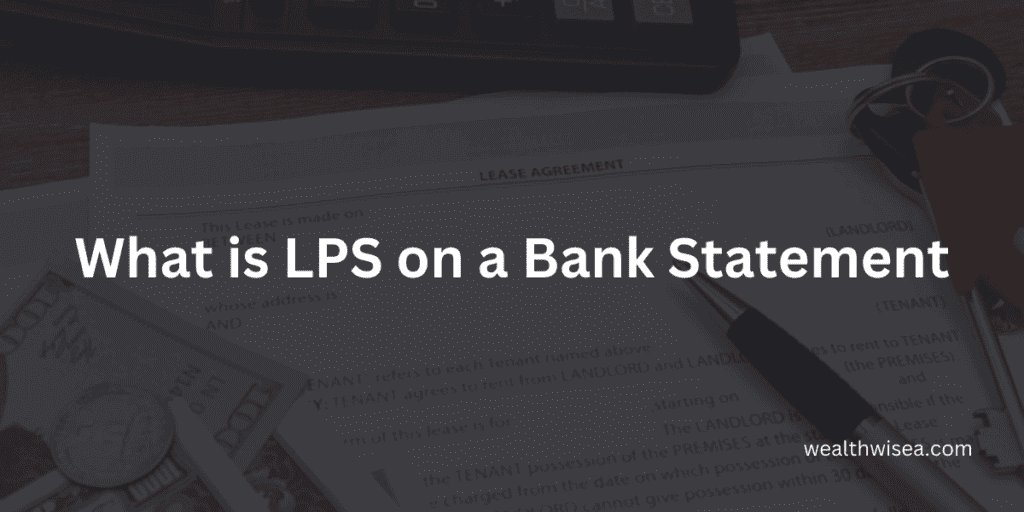What is LPS on a Bank Statement
When reviewing your bank statement, you may come across unfamiliar abbreviations or charges, such as LPS. If you’re asking, “What is LPS on a bank statement?” you’re not alone. Understanding what LPS means can help you better manage your finances and avoid unexpected fees. This article delves into the potential meanings of LPS and provides guidance on what to do if you encounter this term.

Understanding LPS
The abbreviation LPS on a bank statement typically stands for either Late Payment Service or Loan Payment Service. Below, we’ll explore these possibilities in more detail.
Late Payment Service (LPS)
One common meaning of LPS is the Late Payment Service. This charge is often associated with fees incurred due to late payments. Here’s how it works:
What Triggers a Late Payment Fee?
Late payment fees are typically assessed when you fail to make a payment by the due date. Banks and other financial institutions impose these fees as a penalty for delayed payments. The charge compensates for the additional administrative work required to handle late payments and encourages timely payment.
How to Avoid Late Payment Fees
To avoid late payment fees, ensure you make all your payments on or before the due date. Setting up automatic payments or reminders can help you stay on top of your financial obligations and prevent these charges from appearing on your statement.
Loan Payment Service (LPS)
Another possible meaning of LPS is loan payment service. This fee is related to managing or processing payments on a loan. Here’s a closer look:
What is covered by Loan Payment Service Fees?
Loan Payment Service fees can cover various services associated with managing your loan. These may include:
- Processing Fees: charges for handling loan payments.
- Maintenance Fees: Ongoing fees for managing the loan account.
- Service Fees: Additional costs for any special services related to the loan.
These fees are usually detailed in your loan agreement, so reviewing your contract can help you understand what fees might apply.
Reviewing Your Loan Agreement
Review your loan agreement carefully to better understand any charges related to your loan. This document will outline all fees associated with the loan, including those that might appear as LPS on your bank statement.
What to Do if You See LPS on Your Statement
If you encounter an LPS charge on your bank statement and are unsure about its origin or amount, follow these steps:
Contact Your Bank
The best way to clarify any charge on your bank statement is to contact your bank directly. They can provide specific details about the LPS charge and explain why it was applied. Make sure to have your account information handy when you call for a quicker resolution.
Review Your Statements and Agreements
Review your recent bank statements and any agreements related to your accounts or loans. This can help you identify if the charge is due to a missed payment, a loan-related fee, or another reason.
Monitor Your Account Regularly
Regularly monitoring your bank account and statements can help you catch any unexpected charges early. Set up alerts for transactions to stay informed about any changes or fees applied to your account.
Understanding what LPS means and how to handle it can improve your financial management and help you avoid unnecessary fees. Stay informed and proactive to keep your finances on track.
FAQs
1. What does LPS stand for on a bank statement?
LPS on a bank statement typically stands for either Late Payment Service or Loan Payment Service. The exact meaning depends on the context of the charge.
2. What is a Late Payment Service (LPS) fee?
A Late Payment Service (LPS) fee is a charge imposed by a bank or financial institution when a payment is made after the due date. This fee compensates the bank for the additional administrative work associated with processing late payments.
3. How can I avoid LPS fees?
To avoid LPS fees, ensure that all your payments are made on or before their due dates. Setting up automatic payments or reminders can help you keep track of your payment deadlines.
4. What is a Loan Payment Service (LPS) fee?
Loan Payment Service (LPS) fees are charges associated with the management and processing of loan payments. These fees can include processing fees, maintenance fees, or other charges related to managing your loan account.
5. How can I find out more about an LPS charge on my statement?
If you see an LPS charge on your bank statement and are unsure about it, contact your bank directly. They can provide specific details about the charge and explain why it was applied.
6. Where can I find details about my loan-related fees?
Details about loan-related fees, including any that might appear as LPS on your statement, are typically outlined in your loan agreement. Reviewing this document can help you understand the fees associated with your loan.
7. Are there any other common bank statement terms I should know about?
Yes, there are several other terms you might encounter on your bank statement. For example, you can learn more about what POD means here and discover what AEIS refers to here.
8. What should I do if I have questions about multiple charges on my statement?
If you have questions about various charges on your bank statement, it’s best to contact your bank’s customer service. They can provide explanations and help you resolve any issues.




